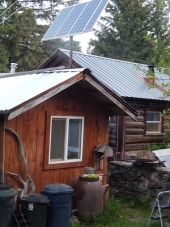




Iterations are fine, we don't have to be perfect
My 2nd Location:Florida HardinessZone:10 AHS:10 GDD:8500 Rainfall:2in/mth winter, 8in/mth summer, Soil:Sand pH8 Flat








"People may doubt what you say, but they will believe what you do."








"You must be the change you want to see in the world." "First they ignore you, then they laugh at you, then they fight you, then you win." --Mahatma Gandhi
"Preach the Gospel always, and if necessary, use words." --Francis of Assisi.
"Family farms work when the whole family works the farm." -- Adam Klaus








S Bengi wrote:I found some frameless, flexible 400W solar panel going for $174 (44cent per watt), they are going for 1/3 the price of a regular solar panel per watt.
http://sunelec.com/solar-panels/sun-395-watt-monocrystalline-solar-panel.html
My only problem is how do I install them?
What are the challenges with these panels?
Would love to hear your thoughts/experience with them.




 1
1




Plans are only good intentions unless they immediately degenerate into hard work -Peter Drucker




Joseph Johnson wrote:I just got10 305 watt framless panels for 129.00 each. 1500.00 for all with shipping. They are not really that flexible but the are working great. My frame is similar to the one above but standing up instead of sideways. I had my sister seal the frames with deck stain/sealer and they look sharp. I currently have 6 of them working because the midnite classic 200 can't handle all ten so I have to order another charge controller. I am using 14 12v 115 ah batteries wired as 24v. And we are producing 8-10 kW per day in Sierra Blanca, TX. The key to using these panels is airflow. My frames are 2x4 notched and assembled like a picture frame. Only 3/4 inch of the panel edges are on the boards and the backs are left exposed. With temps hitting 109 we have had no issues with heat build up. I used clear silicone to glue them to the frames and started to use pieces from the notching to secure them but the fit was so tight, I started removing the slats. We where surprised at the size (78x39) but with 105 acres re have lots of room lol.












Please give me your thoughts on my Affordable, double-paned earthbag window concept





















Eldon Howe wrote:Hi Guys,
I have 40 of these Sanyo 190W Frameless Monocrystalline Solar Panels to install on a metal roof.
I have currently have 3 24v BYD powerwall batteries and I am about to re configure my SW4024.
My question is, Can I use an inverter 240volt at the solar array and connect to the un used generator connection on the existing Snider inverter ?
Sanyo 190W Frameless Monocrystalline Solar Panels
These are Fully Tested Genuine Sanyo 190W Solar Panels at just 15 Cents / Watt that were installed by SUNPOWER! These were manufactured in 2012, installed in 2015, and then removed from service in 2019
That is a return on investment in just 7 months!
Model Number: HIP-190CA9
Maximum Power: 190W
Short Circuit Current: 3.75A
Open Circuit Voltage: 67.5V
Maximum Power Current: 3.47A
Maximum Power Voltage: 54.8V
Max. System Voltage : 600V
These were used for just 4 years on a school that was recently demolished... The
Solar panels come with a pair of 2 foot long mc3 connectors.
Dimensions: 52" x 35" x 3/8"
These are very energy dense solar panels, they're smaller and lighter and easier to carry with just 1 person than the larger 300W panels. These are commercial grade solar panels. There may be a few very minor scratches but we tested every single panel and they're testing like new!
These were mounted to a metal roof using double sided solar acrylic foam tape, this method makes it very easy to install. There are a few popular brands for this solar tape including 3M and LAMATEK but there are many solar acrylic foam tapes on the market that are high bond and adhere to glass and metals, you can find them online. Or you could use liquid nails!
That’s a fantastic price. Even if they might degrade I’d like to get some. Are any more of these panels available. Whee did you get them?

| I agree. Here's the link: http://stoves2.com |


